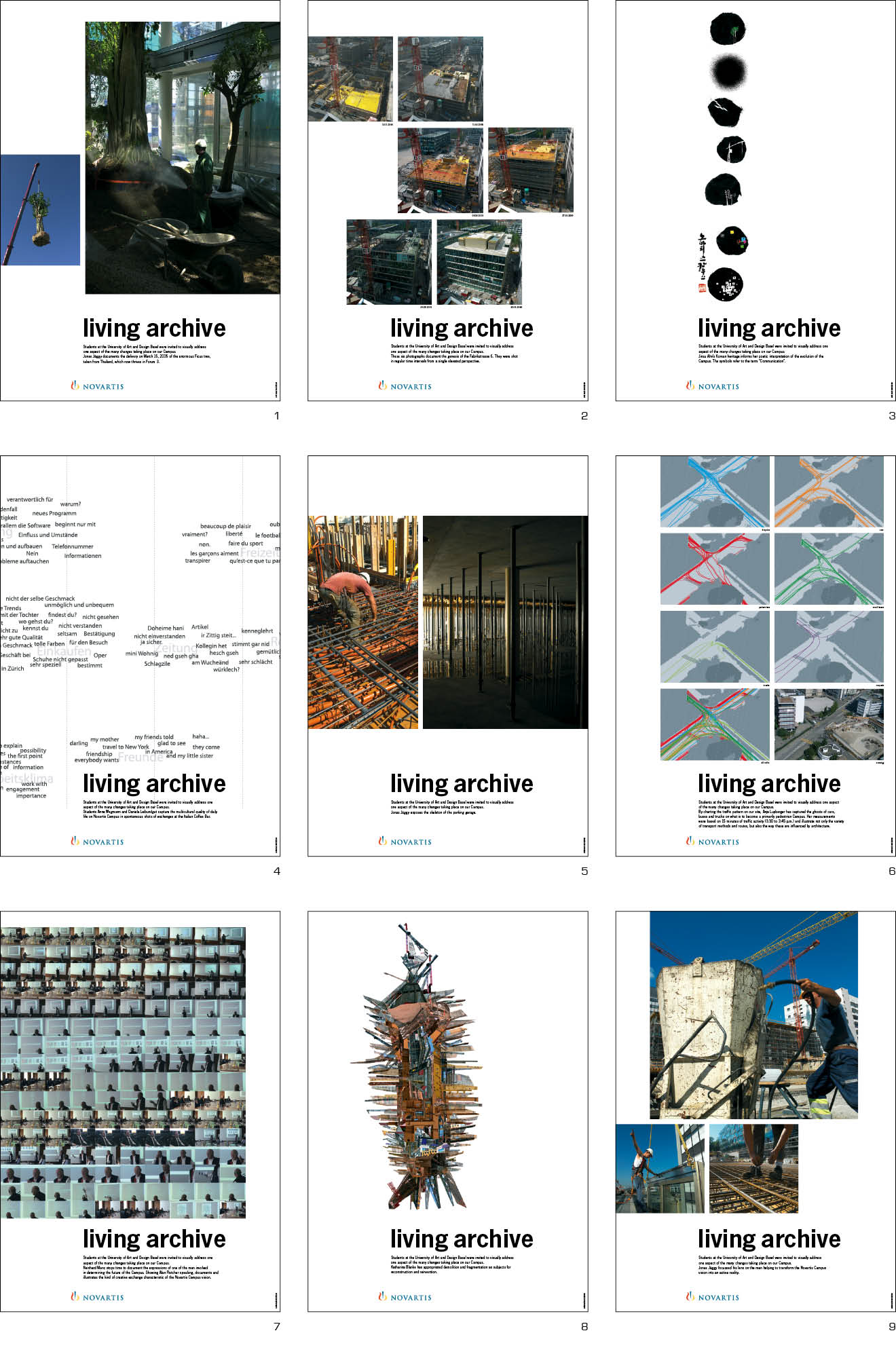
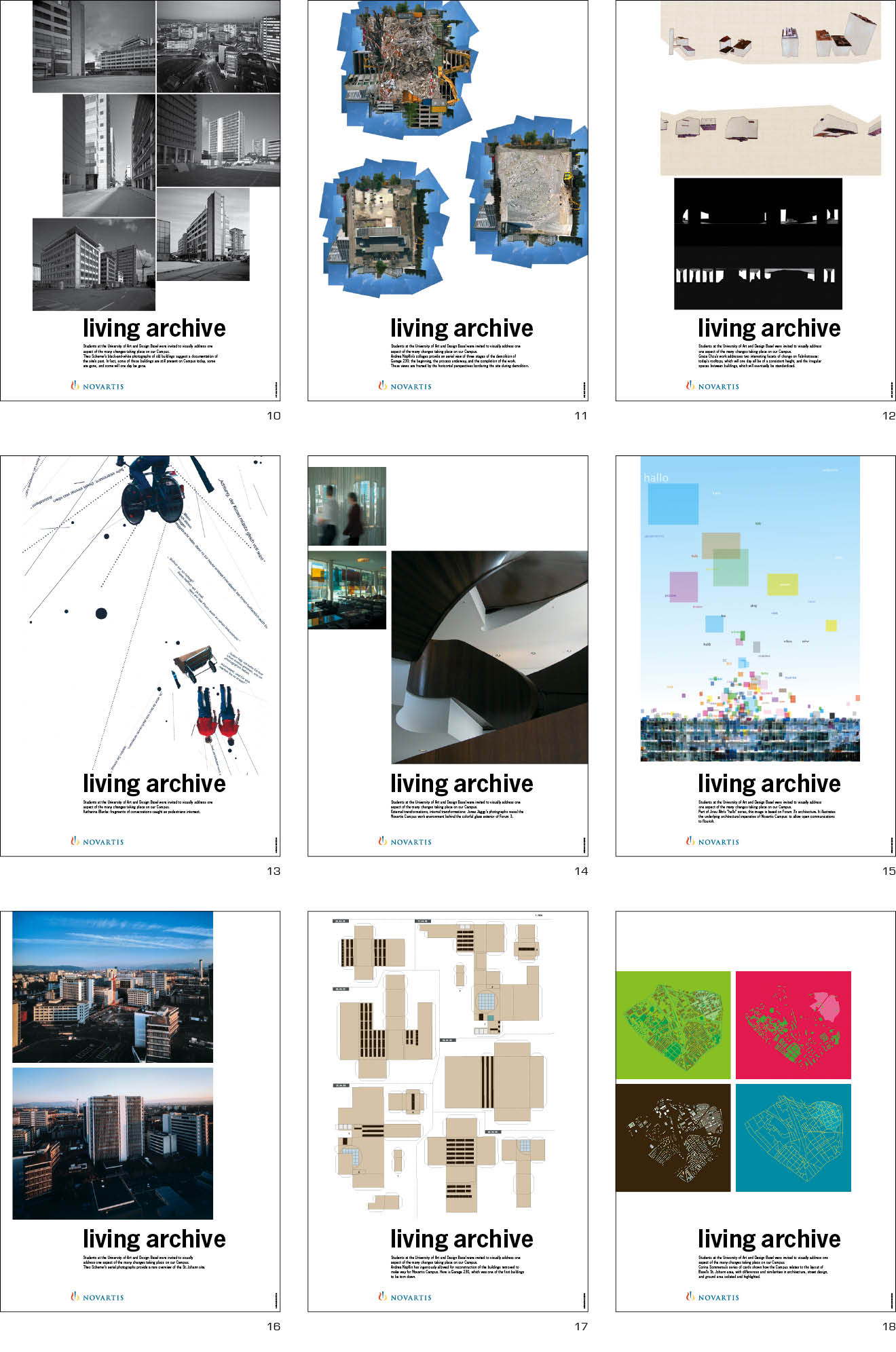
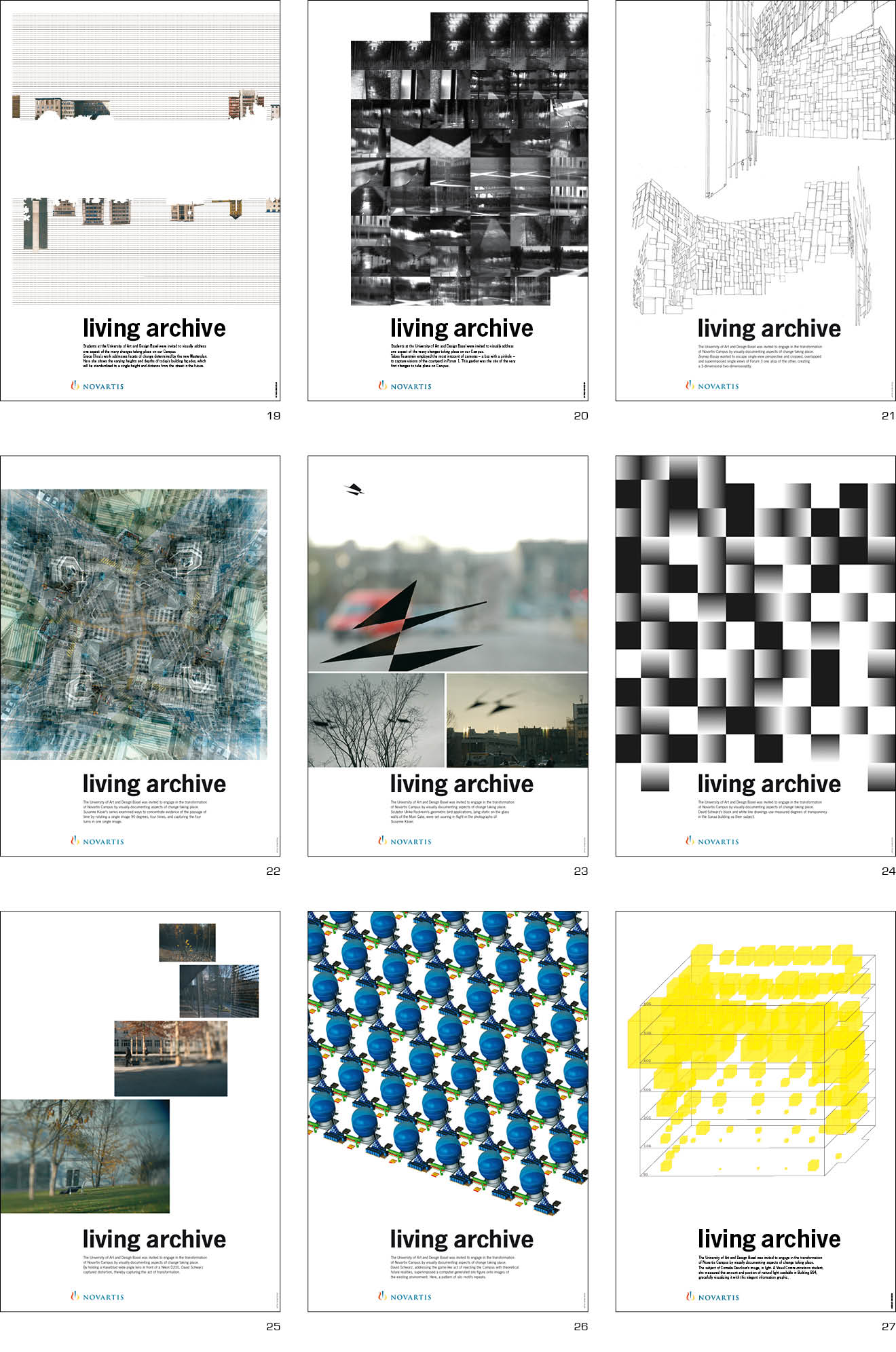
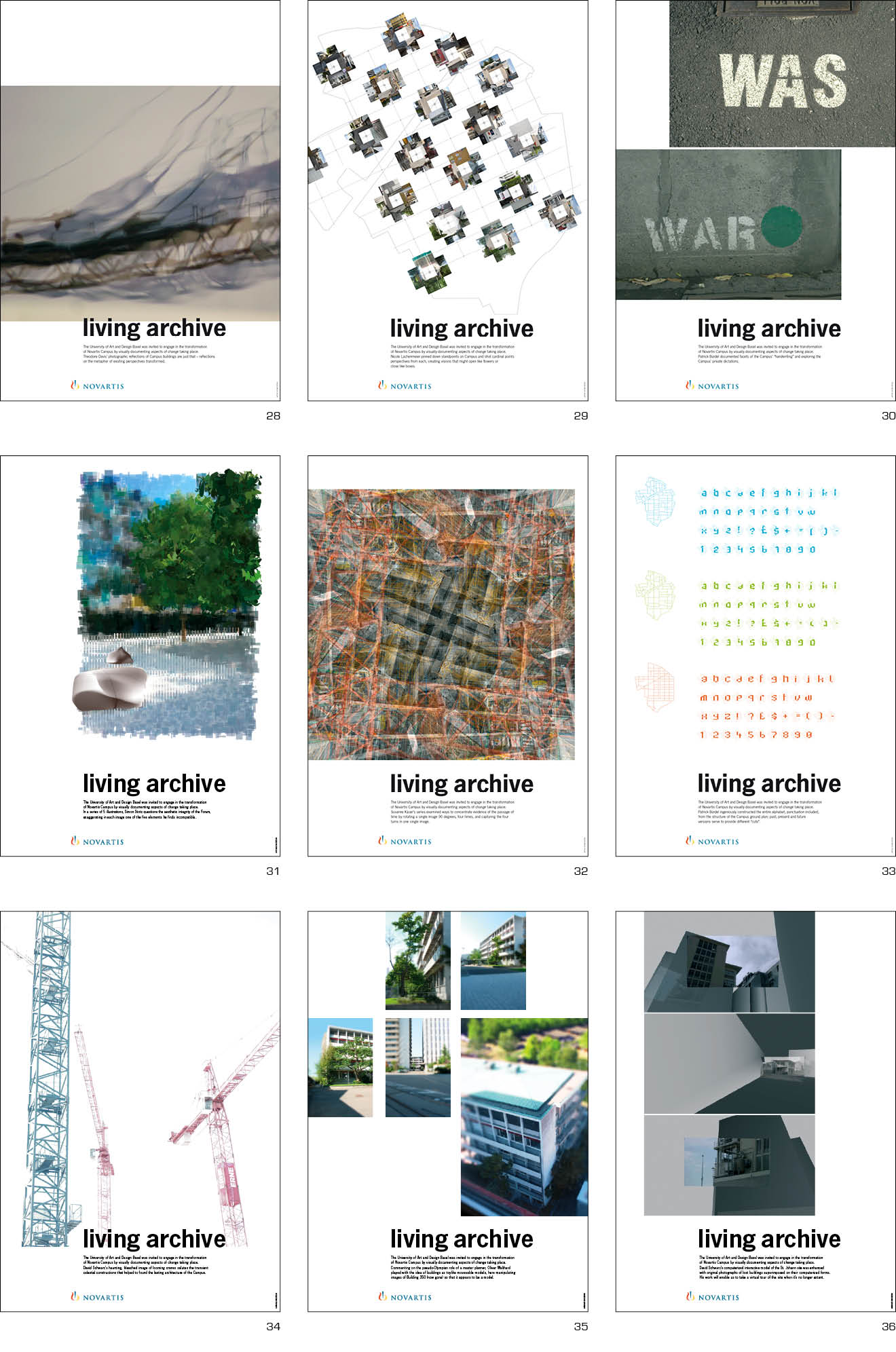
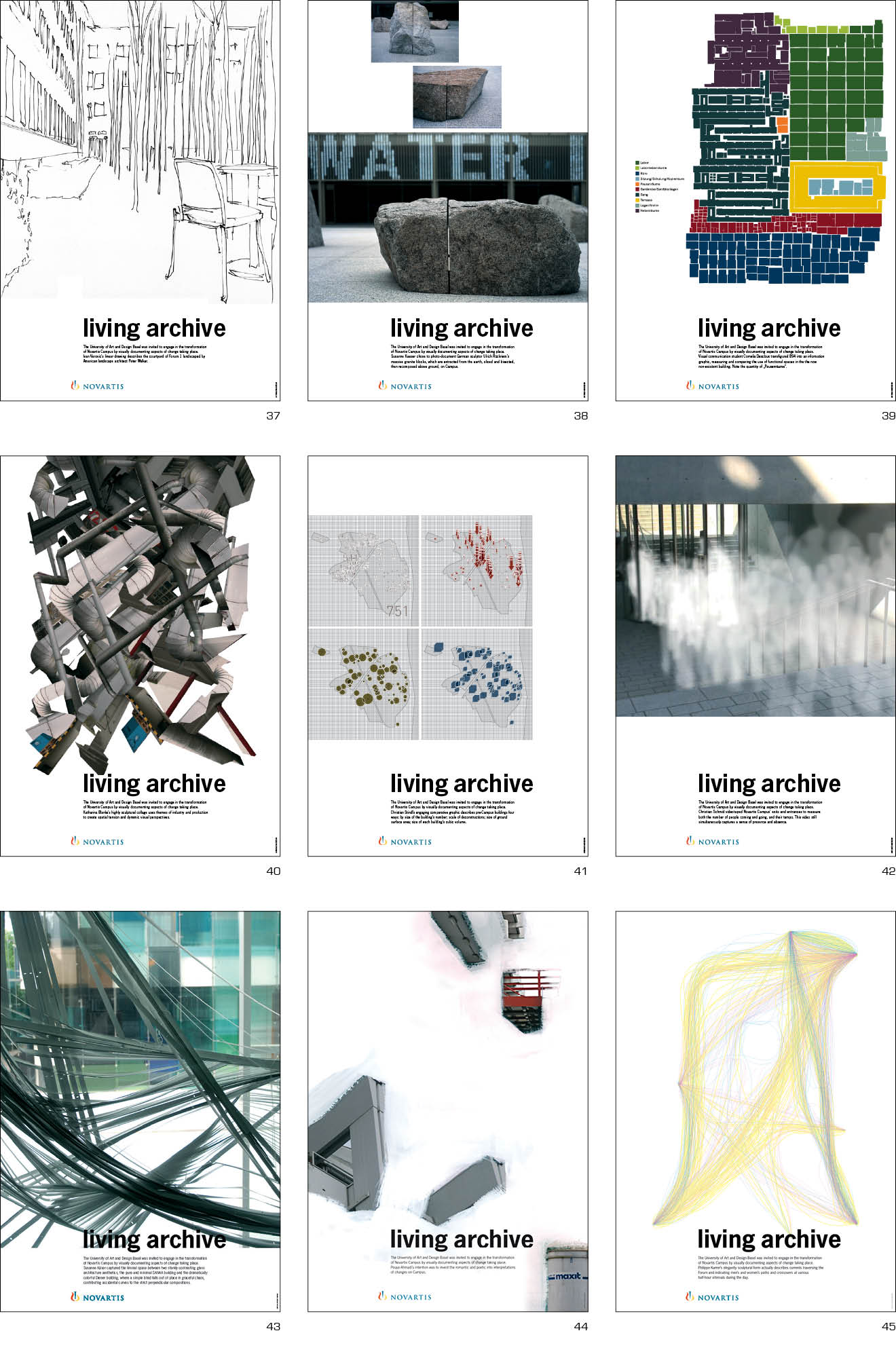
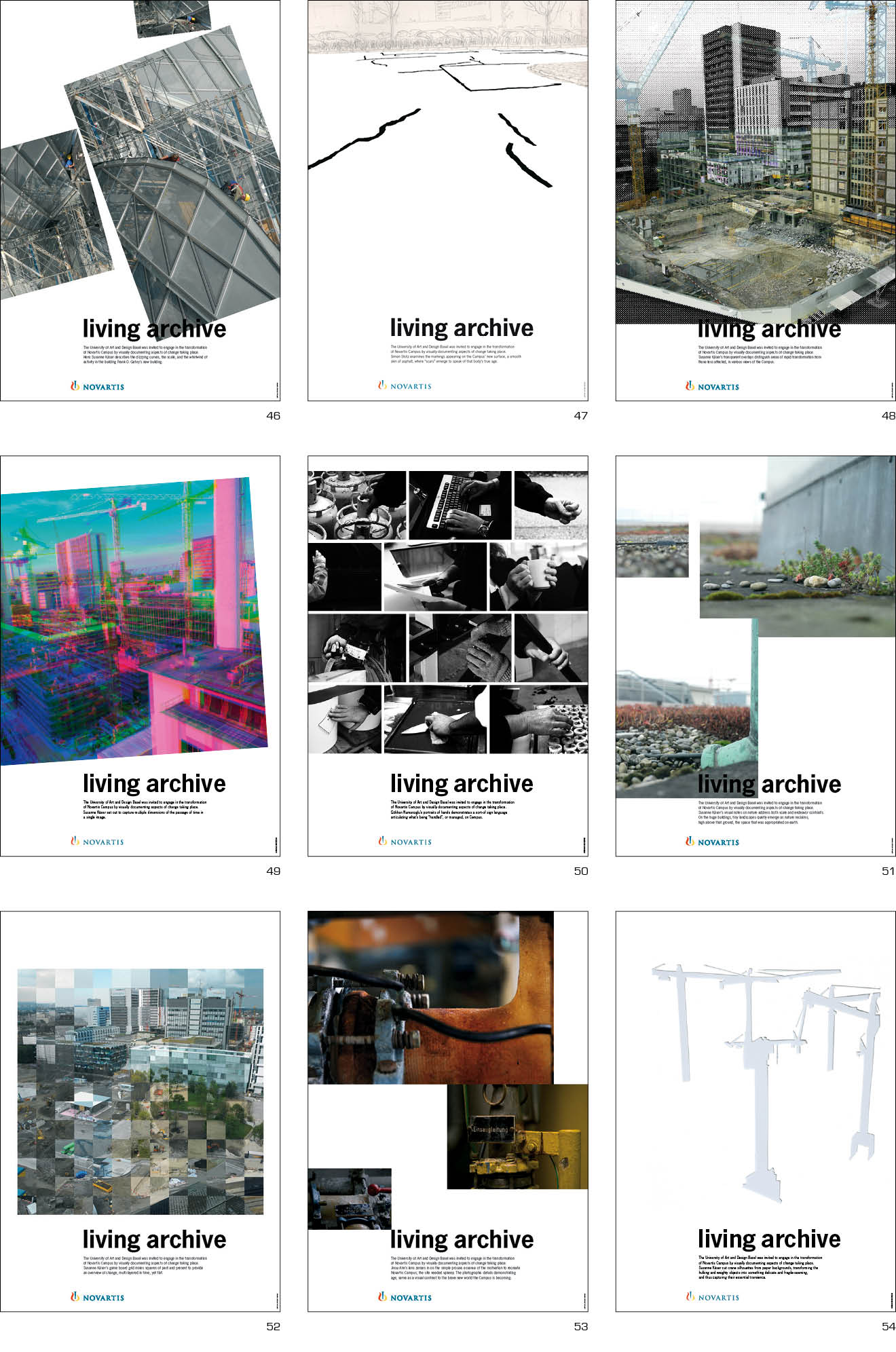
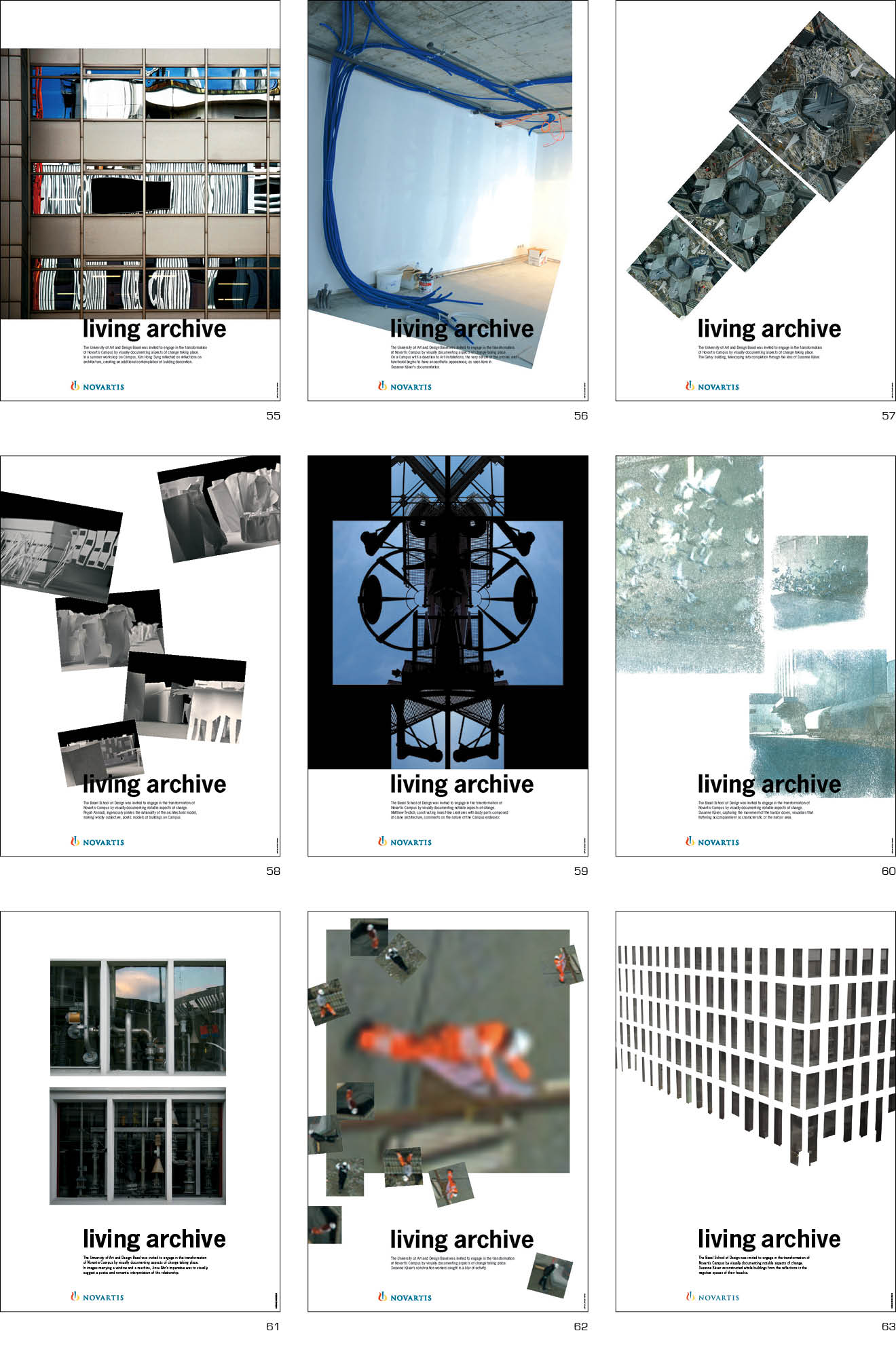
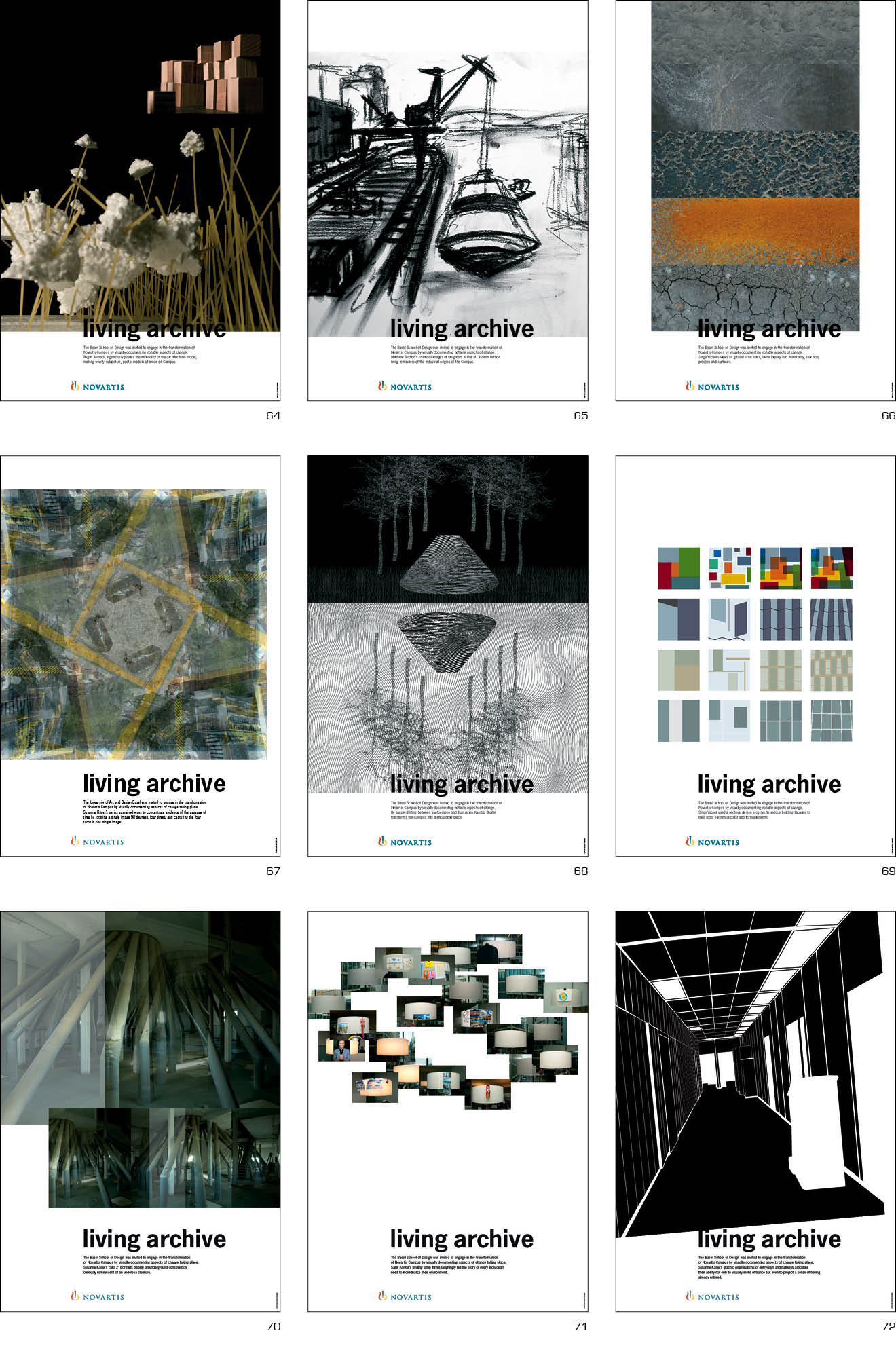
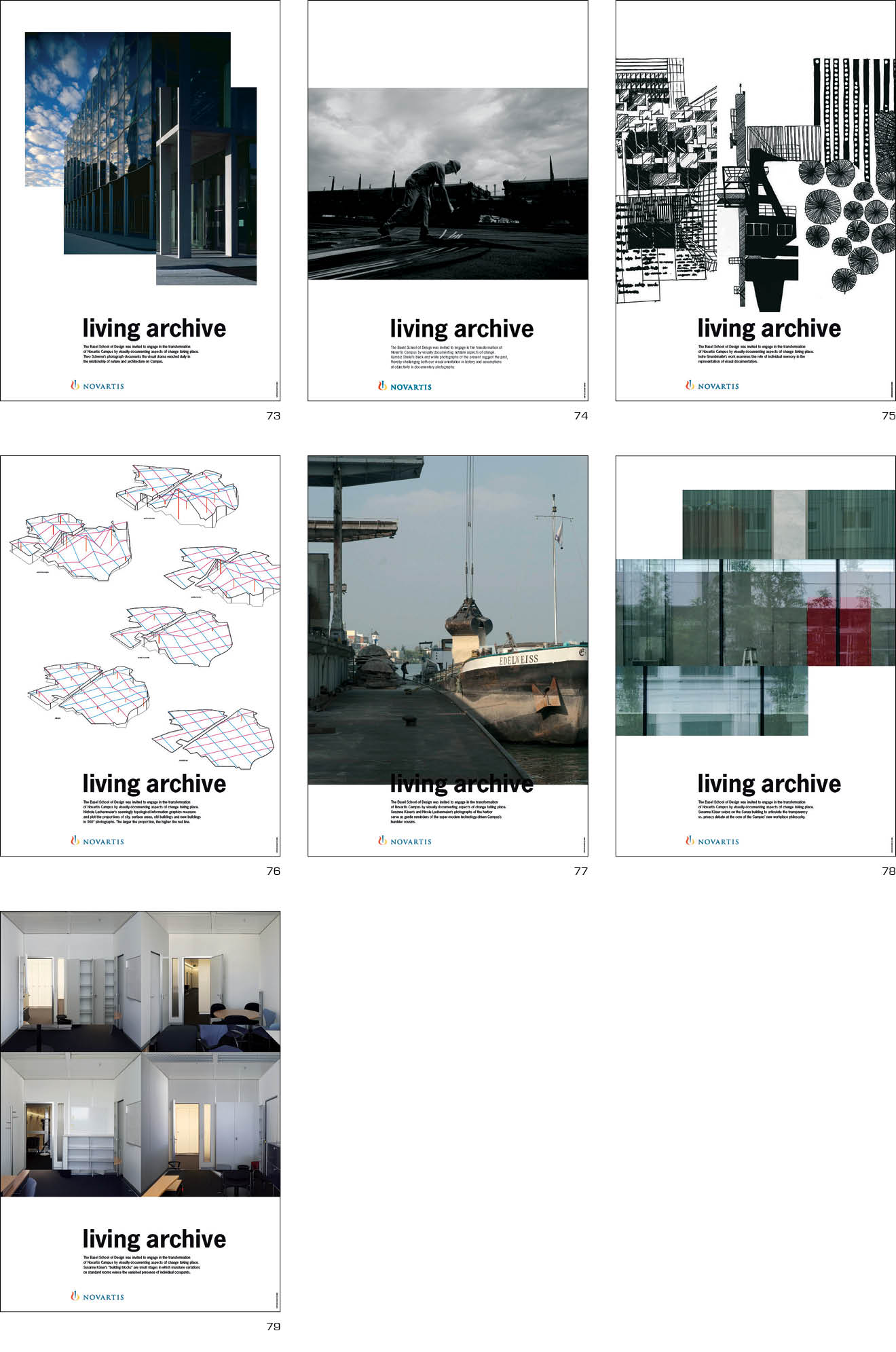
Poster Series Design
Novartis Campus Basel
The HGK Basel was invited on Campus to document the multifaceted changes taking place in the creation of Novartis Campus. We produced a series of posters showcasing the various artists’ works and exhibited the posters on Campus to add insight, dimension and dialogue to the new Campus experience.
1
Jonas Jäggy documents the delivery on March 15, 2005 of the enormous Ficus tree, taken from Thailand, which now thrives in Forum 3.
2
These six photographs document the genesis of the Fabrikstrasse 6. They were shot in regular time intervals from a single elevated perspective.
3
Jinsu Ahn’s Korean heritage informs her poetic interpretation of the evolution of the Campus. The symbols refer to the term “Communication”.
4
Students Anne Wegmann and Daniela Leibundgut capture the multicultural quality of daily life on Novartis Campus in spontaneous shots of exchanges at the Italian Coffee Bar.
5
Jonas Jäggy exposes the skeleton of the parking garage.
6
By charting the traffic pattern on our site, Anja Lupberger has captured the ghosts of cars, buses and trucks on what is to become a primarily pedestrian Campus. Her measurements were based on 15 minutes of traffic activity (3:30 to 3:45 p.m.) and illustrate not only the variety of transport methods and routes, but also the way these are influenced by architecture.
7
Reinhard Manz stops time to document the expressions of one of the men involved in determining the future of the Campus. Showing Alan Fletcher speaking, documents and illustrates the kind of creative exchange characteristic of the Novartis Campus vision.
8
Katharina Blanke has appropriated demolition and fragmentation as subjects for reconstruction and reinvention.
9
Jonas Jäggy focussed his lens on the men helping to transform the Novartis Campus vision into an active reality.
10
Theo Scherrer’s black-and-white photographs of old buildings suggest a documentation of the site’s past. In fact, some of these buildings are still present on Campus today, some are gone, and some will one day be gone.
11
Andrea Näpflin’s collages provide an aerial view of three stages of the demolition of Garage 230: the beginning, the process underway, and the completion of the work. These views are framed by the horizontal perspectives bordering the site during demolition.
12
Grace Chou’s work addresses two interesting facets of change on Fabrikstrasse: today’s rooftops, which will one day all be of a consistent height, and the irregular spaces between buildings, which will eventually be standardized.
13
Katharina Blanke: fragments of conversations caught as pedestrians intersect.
14
External transformations, internal transformations: Jonas Jäggy’s photographs reveal the Novartis Campus work environment behind the colorful glass exterior of Forum 3.
15
Part of Jinsu Ahn’s “hello” series, this image is based on Forum 3’s architecture. It illustrates the underlying architectural imperative of Novartis Campus: to allow open communications to flourish.
16
Theo Scherrer’s aerial photographs provide a rare overview of the St. Johann site.
17
Andrea Näpflin has ingeniously allowed for reconstruction of the buildings removed to make way for Novartis Campus. Here is Garage 230, which was one of the first buildings to be torn down.
18
Corina Sommerau’s series of cards shows how the Campus relates to the layout of Basel’s St. Johann area, with differences and similarities in architecture, street design, and ground area isolated and highlighted.
19
Grace Chou’s work addresses facets of change determined by the new Masterplan. Here she shows the varying heights and depths of today’s building façades, which will be standardized to a single height and distance from the street in the future.
20
Tabea Feuerstein employed the most innocent of cameras – a box with a pinhole – to capture visions of the courtyard in Forum 1. This garden was the site of the very first changes to take place on Campus.
21
Zeynep Basay wanted to escape single-view perspective and cropped, overlapped superimposed single views of Forum 3 one atop of the other, creating a 3-dimensional two-dimensionality.
22
Susanne Käser’s series examined ways to concentrate evidence of the passage of time into a single image.
23
Sculptor Ulrike Ruckreim’s geometric bird applications, lying static on the glass walls of the Main Gate, were set soaring in flight in the photographs of Susanne Käser.
24
David Schwarz’s black and white line drawings use measured degrees of transparency in the Sanaa building as their subject.
25
By holding a Haselblad wide-angle lens in front of a Nikon D200, David Schwarz captured distortion, thereby capturing the act of transformation.
26
David Schwarz, addressing the game-like act of injecting the Campus with theoretical future realities, superimposed a computer-generated silo figure onto images of the existing environment. Here, a pattern of silo motifs repeats.
27
The subject of Cornelia Descloux’s image, is light. A Visual Communications student, she measured the amount and position of natural light available in Building B94, gracefully visualizing it with this elegant information graphic.
28
Theodore Davis’ photographic reflections of Campus buildings are just that – reflections on the metaphor of existing perspectives transformed.
29
Nicole Lachenmeier pinned down standpoints on Campus and shot cardinal points perspectives from each, creating visions that might open like flowers or close like boxes.
30
Patrick Bürdel documented facets of the Campus’ “handwriting” and exploring the
Campus’ private dictations.
31
In a series of 5 illustrations, Simon Stotz questions the aesthetic integrity of the Forum, exaggerating in each image one of the five elements he finds incompatible.
32
Susanne Käser’s series examined ways to concentrate evidence of the passage of time into a single image.
33
Patrick Bürdel ingeniously constructed the entire alphabet, punctuation included, from the structure of the Campus ground plan; past, present and future versions serve to provide different “cuts”.
34
David Schwarz’s haunting, bleached image of looming cranes salutes the transient celestial constructions that helped to found the lasting architecture of the Campus.
35
Commenting on the pseudo-Olympian role of a master planner, Oliver Walthard played with the idea of buildings as toylike movevable models, here manipulating images of Building 350 (now gone) so that it appears to be a model.
36
David Schwarz’s computerized interactive model of the St. Johann site was enhanced with original photographs of lost buildings superimposed on their computerized forms. His work will enable us to take a virtual tour of the site when it’s no longer extant.
37
Ivan Verovic’s linear drawing describes the courtyard of Forum 1 landscaped by American landscape architect Peter Walker.
38
Susanne Kaeser chose to photo-document German sculptor Ulrich Rückriem’s massive granite blocks, which are extracted from the earth, sliced and bisected, then recomposed above ground, on Campus.
39
Visual communication student Cornelia Descloux transfigured B94 into an information graphic, measuring and comparing the use of functional spaces in the the now non-exisitent building. Note the quantity of „Pausenräume“.
40
Katharina Blanke’s highly sculptural collage uses themes of industry and production to create spatial tension and dynamic visual perspectives.
41
Christian Stindl’s engaging comparative graphic describes pre-Campus buildings four ways: by size of the building’s number; scale of deconstructions; size of ground surface area; size of each building’s cubic volume.
42
Christian Schmid videotaped Novartis Campus’ exits and entrances to measure both the number of people coming and going, and their tempo. This video still simultaneously captures a sense of presence and absence.
43
Susanne Käser captured the liminal space between two starkly contrasting glass architecture aesthetics, the pure and minimal SANAA building and the dramatically colorful Diener building, where a simple blind falls out of place in graceful chaos, contributing accidental curves to the strict perpendicular compositions.
44
Pouya Ahmadi’s intention was to invest the romantic and poetic into interpretations of changes on Campus.
45
Philippe Karrer’s elegantly sculptural form actually describes currents traversing the Forum and indicating men’s and women’s paths and crossovers at various half-hour intervals during the day.
46
Here Susanne Käser describes the dizzying curves, the scale, and the whirlwind of activity in the building Frank O. Gehry's new building.
47
Simon Stotz examines the markings appearing on the Campus’ new surface, a smooth skin of asphalt, where “scars” emerge to speak of that body’s true age.
48
Susanne Käser's transparent overlays distinguish areas of rapid transformation from those less affected, in various views of the Campus.
49
Susanne Käser set out to capture multiple dimensions of the passage of time in a single image.
50
Gökhan Numanoglu’s portraits of hands demonstrates a sort-of sign language articulating what’s being “handled”, or managed, on Campus.
51
Susanne Käser's visual notes on nature address both scale and endeavor contrasts. On the huge buildings, tiny landscapes quietly emerge as nature reclaims, high above that ground, the space that was appropriated on earth.
52
Susanne Käser's game board grid mixes squares of past and present to provide an overview of change, multi-layered in time, yet flat.
53
Jinsu Ahn's lens zeroes in on the simple prosaic essence of the motivation to recreate Novartis Campus; the site needed upkeep. The photographic details demonstrating age, serve as a visual contrast to the brave new world the Campus is becoming.
54
Susanne Käser cut crane silhouettes from paper backgrounds, transforming the hulking and weighty objects into something delicate and fragile-seeming, and thus capturing their essential transience.
55
In a summer workshop on Campus, Kim Hong Sung reflected on reflections on architecture, creating an additional contemplation of building decoration.
56
On a Campus with a devotion to Art installations, the very nature of the prosaic and functional begins to have an aesthetic appearance, as seen here in Susanne Käser's documentation.
57
The Gehry building, telescoping into completion through the lens of Susanne Käser.
58
Pegah Ahmadi, ingeniously pirates the rationality of the architectural model, making wholly subjective, poetic models of buildings on Campus.
59
Matthew Terdich, constructing insect-like creatures with body parts composed of crane architecture, comments on the nature of the Campus endeavor.
60
Susanne Käser, capturing the movement of the harbor doves, visualizes that fluttering accompaniment so characteristic of the harbor area.
61
In images marrying a window and a machine, Jinsu Ahn’s imperative was to visually suggest a poetic and romantic interpretation of the relationship.
62
Susanne Käser's construction workers caught in a blur of activity.
63
Susanne Käser reconstructed whole buildings from the reflections in the negative spaces of their facades.
64
Pegah Ahmadi, ingeniously pirates the rationality of the architectural model, making wholly subjective, poetic models of areas on Campus.
65
Matthew Terdich's charcoal images of freighters in the St. Johann harbor bring reminders of the industrial origins of the Campus.
66
Singe Yüceel’s views of ground structures, invite inquiry into materiality, function, process and surfaces.
67
Susanne Käser’s series examined ways to concentrate evidence of the passage of time into a single image.
68
By shape-shifting between photography and illustration Kambiz Shafei transforms the Campus into a enchanted place.
69
Singe Yüceel used a vectoral design program to reduce building facades to their most elemental color and form elements.
70
Susanne Käser’s “Silo 2” portraits display an underground construction curiously reminiscent of an undersea creature.
71
Safat Korkut’s smiling lamp forms laughingly tell the story of every individual’s need to individualize their environment.
72
Susanne Käser’s graphic examinations of entryways and hallways articulate their ability not only to visually invite entrance but even to project a sense of having already entered.
73
Theo Scherrer’s photograph documents the visual drama enacted daily in the relationship of nature and architecture on Campus.
74
Kambiz Shafei’s black and white photographs of the present suggest the past, thereby challenging both our visual orientation in history and assumptions of objectivity in documentary photography.
75
Indre Grumbinaite’s work examines the role of individual memory in the representation of visual documentation.
76
Nichole Lachenmeier’s seemingly topological information graphics measure and plot the proportions of sky, surface areas, old buildings and new buildings in 360° photographs. The larger the proportion, the higher the red line.
77
Susanne Käser’s and Nicole Lachenmeier’s photographs of the harbor serve as gentle reminders of the super-modern technology-driven Campus’s humbler cousins.
78
Susanne Käser seizes on the Sanaa building to articulate the transparency vs. privacy debate at the core of the Campus’ new workplace philosophy.
79
Susanne Käser’s “building blocks” are small stages in which mundane variations on standard rooms evince the vanished presence of individual occupants.
